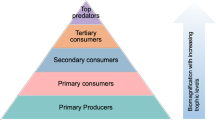Abstract
The present study focused on the measurement of 14C levels by using a passive sampling technique. The sampling period is optimized by exposing the 0.5 N NaOH solution to air and measuring the amount of carbon absorbed. The optimum sampling duration for measurement of 14C in the atmospheric CO2 is found as one day. The absorbed CO2 in NaOH solution was recovered by adding barium chloride, and an average recovery yield was found to be 98.67 ± 0.29%. The average specific activity of 14C for samples collected in two locations is 239.04 ± 25.45 Bq/kg C and 242.89 ± 18.22 Bq/kg C.






Similar content being viewed by others
References
Libby WF (1945) Atmospheric helium three and radiocarbon from cosmic radiation. Phys Rev 69:671–672
IAEA (2004) Management of waste containing tritium and carbon. Technical reports, Series no 421. International Atomic Energy Agency, Vienna, Austria
UNSCEAR (2000) Sources and effects of ionizing radiation; United Nations Scientific Committee on the Effects of Atomic Radiation, New York, USA.
Stenström K, Erlandsson B, Mattsson S, Thornberg C, Hellborg R, Kiisk M, Persson P, Skog G (2000) 14C Emission from Swedish Nuclear Power Plants and its Effect on the 14C Levels in the Environment. Internal Report LUNDFD6/(NFFR- 3079). Lund University
Dias CM, Stenström K, Bacelar Leão IL, Santos RV, Nícoli IG, Skog G, Ekström P, da Silveira CR (2009) 14CO2 Dispersion around two PWR nuclear power plants in Brazil. J Environ Radioact 100:574–580
Woo HJ, Chun SK, Cho SY, Kim YS, Kang DW, Kim EH (1999) Sample treatment techniques for determination of environmental radiocarbon in the nuclear power station area. J Radio Anna Nucl Chem 239(3):533–538
Peng Y, Zhao B, Li L (2012) Advance in post-combustion CO2 capture with alkaline solutions: A brief review. Energy Procedia 14:1515–1522
Krekel D, Samsun RC, Peters R, Stolten D (2018) The separation of CO2 from ambient air—A techno-economic assessment. Appl Energy 218:361–381
Lackner KS (2009) Capture of carbon dioxide from ambient air. Eur Phys J Special Top 176:93–106
Górecki T, Namieśnik J (2002) Passive sampling Trends in analytical chemistry 21(4):276–291
Tuduri L, Millet M, Briand O, Montury M (2012) Passive air sampling of semi-volatile organic compounds. Trends Anal Chem 31:38–49
Garnett MH, Hartley IP (2010) Passive sampling method for radiocarbon analysis of atmospheric CO2 using molecular sieve. Atmos Environ 44:877–883
Garnett MH, Murray C (2013) Processing of CO2 samples collected using Zeolite molecular sieve for 14C analysis at the NERC radiocarbon facility (East Kilbride, UK). Radiocarbon 55:410–415
Walker JC, Xu X, Fahrni SM, Lupascu M, Czimczik CI (2015) Developing a passive trap for diffusive atmospheric 14CO2 sampling. Nucl Inst Methods Phys Res B 361:632–637
Hou X (2018) Tritium and 14C in the environment and nuclear facilities: sources and analytical methods. J Nucl Fuel Cycle Waste Technol 16(1):11–39
Milton GM, Brown RM (1993) A review of analytical techniques for the determination of carbon-14 in environmental samples. Rep. AECL-10803, Atomic Energy of Canada Ltd, Chalk River
Yoo M, Han S-J, Wee J-H (2013) Carbon dioxide capture capacity of sodium hydroxide aqueous solution. J Environ Manag 114:512–519
Qureshi RM, Aravena R, Fritz P, Drimmie R (1989) The CO2 absorption method as an alternative to benzene synthesis method for 14C dating. Appl Geochem 4(6):625–633
Woo HJ, Chun SK, Cho SY, Kim YS, Kang DW, Kim EH (1999) Optimization of liquid scintillation counting techniques for the determination of carbon-14 in environmental samples. J Radio Anal Nucl Chem 239(3):649–655
Arun B, Vijayalakshmi I, Ramani Y, Viswanathan S, Jose MT, Baskaran R, Venkatraman B (2020) Optimization of 14C LSC measurement using CO2 absorption technique. Radio Chim Acta 108(4):297–303
Broda R (2003) A review of the triple-to-double coincidence ratio (TDCR) method for standardizing radionuclides. Appl Radiat Isot 58(5):585–594
Bharath S, Arya Krishnan K, D’Souza RS, Rashmi Nayak S, Ravi PM, Sharma R, Kumar P, Chopra S, Karunakara N (2021) Optimisation of CO2 absorption and liquid scintillation counting method for carbon-14 specific activity measurement in atmospheric air. Appl Radiat Isot 172:1085
Acknowledgements
The authors are grateful to Ms. I. Vijalakshmi and Ms. Y. Ramani from Radiation Safety and Environmental Division, IGCAR, for their support during experimental work.
Author information
Authors and Affiliations
Contributions
B.A. Conceptualization, Experimental Analysis, Investigation, data analysis, and writing the manuscript. S.V.: responsible for formal analysis. M.M.: Review & editing. R.V.: Review & editing. M.T.J.: Conceptualization, Writing- Review & editing, Investigation, Visualization, Resources, Supervision. B.V.: Resources, Supervision, Project administration.
Corresponding author
Ethics declarations
Conflict of interest
The authors declare that they have no financial interests or personal relationships that could influence the work reported in this paper.
Additional information
Publisher's Note
Springer Nature remains neutral with regard to jurisdictional claims in published maps and institutional affiliations.
Rights and permissions
About this article
Cite this article
Arun, B., Viswanathan, S., Menaka, M. et al. Passive sampling technique for atmospheric 14C measurements. J Radioanal Nucl Chem 331, 799–805 (2022). https://doi.org/10.1007/s10967-021-08177-x
Received:
Accepted:
Published:
Issue Date:
DOI: https://doi.org/10.1007/s10967-021-08177-x




